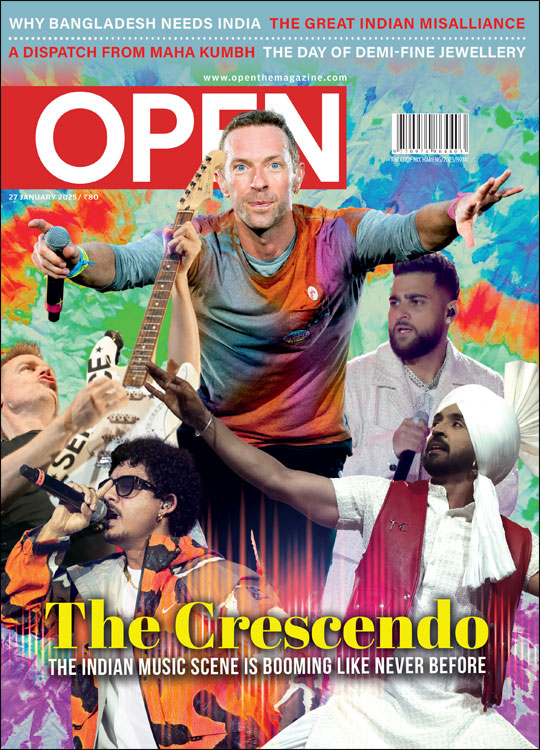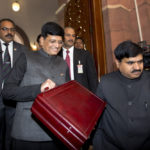Of Bullet Trains and Bullock Carts
From Coca-Cola to colour TV to computers, technological advances in India have always been resisted as anti-poor
 Siddharth Singh
Siddharth Singh
 Siddharth Singh
Siddharth Singh
 |
21 Sep, 2017
|
21 Sep, 2017
/wp-content/uploads/2017/09/Bullettrain1.jpg)
THE DILIP KUMAR and Vyjayanthimala starrer Naya Daur (1957) was one of the earliest films in Independent India to delve into the perils of industrialisation. The theme was simple if intensely emotional: an unequal fight for the survival of horse-carts against newly introduced buses as a means of transport. Like a good Indian film, the horse-cart wins, even if only for a speck in time.
Ideologically, horse-carts have had an upper hand in India ever since, if not earlier, and even 60 years later, something similar is being waged. This time, however, the fight is between a Japanese bullet train and the derelict wagons on rails that most Indians ride. Much has been made of how elitism of this kind has the potential to destroy the Indian Railways, serving and retired officials of which have railed against the new train that will run from Mumbai to Ahmedabad.
There is a pattern to the arguments that have been made against the bullet train. They started with the project’s financing and ended at it being an elitist and inegalitarian concept. Consider the cost first. Of the total bill of Rs 1.1 lakh crore, Rs 88,000 crore will come from Japan in the form of a 50-year loan at an annual rate of 0.1 per cent interest. There will also be a 15-year moratorium on repayment. This has led to claims that the overall cost of the loan, and hence the project, may be substantially higher than the estimated Rs 1.1 lakh crore.
At this point, the case against the bullet train tends to switch tracks to the relative allocation of resources in the Indian economy. If the finally cost of the project is likely to be around Rs 1.5 lakh crore, aren’t there better uses for that money? For example, investing in India’s crumbling railway track infrastructure, instead of a ‘prestige project’. Then comes the issue of investing selectively in the Mumbai-Ahmedabad corridor: why invest there, why not in some underdeveloped part of the country like Bihar? Even if one leaves aside insinuations about the project being launched on the eve of state elections in Gujarat, the welter or arguments, claims and counterclaims is incoherent at best.
Consider the revival of dilapidated railway tracks and other worthwhile investments. The poor state of the network has been in the making for long. In the decade or so before the Narendra Modi Government was sworn in, investment in track infrastructure was next to nil. Reason? The Railways had no money for the purpose. The ‘earnings’ from passenger traffic were, to put it mildly, in the negative. The freight business, overcharged and burdened by cross-subsidies for passengers, could never keep pace with the changing needs of the Indian economy. There is no doubt that fixing the track system needs money, but there is little economic rationale in conflating the bullet train with that. If anything, raising passenger fares and de-politicising fare increases—by having a separate tariff authority— would be the first step to ensure regular railway safety.
Linked to this is the issue of locating the project in Maharashtra and Gujarat. The answer to the question ‘Why not Bihar?’ is simple: where can one find paying customers for a bullet train? They are likely to be found in thriving business centres and commercial zones of the country.
The decision by George Fernandes to produce an ‘Indian’ carbonated drink in the 70s came to nothing beyond a disruption of consumer choice. Today, everyone drinks coke and pepsi with gusto
If one leaves aside all concerns about the project—some of which may be genuine—the opposition to it is ideological. The fear of the usual classes that bear a red flag—literally—is this: once a better and faster mode of transportation is found, paying consumers will ‘exit’ the old trains for the bullet version, leaving the poor to chug along on rusty rails. The silent hope is that if passengers with money remain stuck with them on delayed trains, then their ‘voice’—yelling for better services—would have a far better chance to improve the Railways. It is a dreary claim that has been made by Leftists in sectors as diverse as education, transport, consumer goods and more. Only bullock carts are immune to it.
The bullet train is the latest in a series of ideas, projects and goods that have been resisted at some point or the other since the 1960s in the name of the poor and social progress, but in reality due to purely political reasons that hinge on ideology. Often, the opposition is couched in emotional terms.
Perhaps the best example of this was the fate that befell Coca- Cola in 1977. That was a heady year. Indira Gandhi had lifted the Emergency a while earlier. She also lost that year’s General Election. In came a motley group of socialists, Gandhians, and for the first time, conservative politicians. At that time, The Coca-Cola Company had 22 bottling plants in India, but the market—a word rarely used for the country back then—accounted for just 1 per cent of its global sales.
Within months of coming to power, the Janata Party Government’s Industries Minister, an old firebrand socialist called George Fernandes asked Coke and IBM, the two most visible Multinational Corporations (MNCs) in India, to dilute their holdings in their Indian ventures or leave. In effect, the choice given to these companies was to either part with their proprietary technology—in Coca-Cola’s case, the secret formula for its main carbonated drink—or close down domestic operations. The minister used a law that had been minted four years earlier, the Foreign Exchange Regulation Act, to issue this diktat. Ironically, this was a law passed by Indira Gandhi’s government at the high tide of socialism in India.
What was offered to Indians after the cola giant left the country was a new drink that went by the celebratory name, Double Seven. If the political symbolism in the drink was powerful— the 77 signifying the Congress party’s rout—the fizz was missing altogether. Manufactured by Modern Foods, a government- run company that manufactured bread and other items, the formula for the drink, provided by a government lab, was no match for the original cola. Few consumers took to it, and when Gandhi came back to power in 1980, the new Government predictably lost interest in the project.
Coca-Cola and colour TV had a middle-class aspirational air about them, an attribute that made it easy to launch high-decibel campaigns against them
Old-timers recall the Pure Drinks factory, tucked away in a lane near what was then Connaught Place, which used to bottle Coca-Cola. Once the MNC left, the factory began producing a local variety called Campa Cola that lasted a while. But the plant’s bottling operations never got back the buzz of earlier times. The company still exists, but after the liberalisation of 1991, the cola turf turned out to be uneven. Today, Coke is back and Pepsi is around as well. Consumers have taken to the drinks with gusto and the present generation of Indians does not remember the ideological fervour generated in the 70s to produce an ‘Indian’ carbonated drink. In the end, nothing came of it beyond a disruption of consumer choice and the businesses of bottlers.
A BOTTLE OF COKE was not the only item subject to ideological assault. Some years after the soft drink got the boot and Double Seven crashed, the same act was repeated with colour TV. The year was 1982, in the latter part of which Delhi was to host the IX Asian Games. Making a success of the sports spectacle was supposed to mark India’s coming of age. No expense was spared. The Union Information and Broadcasting Minister Vasant Sathe declared that “nature is in colour”. It was his slogan to rescue Indian TV broadcasts, a Doordarshan monopoly then, from the black-and-white era. He managed to convince the Cabinet to go for the switch. Pakistan TV had gone colour five years earlier without the bruising debate seen in India.
What happened next was eerily similar to the controversy swirling around the bullet train these days. It had virtually the same ingredients: insinuations about the leader pushing for it and the ‘economic’ impact of the change. Like Modi, Sathe’s project was declared ‘political’. Then, as now, the gossip mill in Delhi hinted at the minister’s ambition to become President of the country, and the colour TV project as his chosen vehicle for the ascent.
The economic case against colour TV depended on a complex interpretation of income forgone by the Government due to losses in the collection of custom duties. In the months preceding the Asiad, the Centre had relaxed import rules for bringing colour TV sets into India from abroad. At that time, much was made of the fact that one could import the good stuff by paying ‘only 145 per cent duty’. Then there was the issue of protecting domestic public sector units manufacturing black-and-white sets. Bharat Electronics Ltd, for example, had just invested in a new plant near Mumbai to make key components for locally produced sets. The Electronics Commission—a body that sketched policy—fought Sathe’s proposal tooth and nail. Comparisons were made between the cost of the two kinds of TV sets in India and other countries. The conclusion was simple: CTVs would cost much more to produce in India and thus divert scarce resources that were much needed elsewhere. India did eventually go colour and the debate died down. The positive spin-offs of that decision are far too obvious now to call for a serious evaluation of its wisdom.
Coca-Cola and colour TV had too much of a middle-class aspirational air about them, an attribute that made it easy for opponents to launch high-decibel campaigns against them. There were other diffuse cases of development that attracted criticism even if their contribution to the well-being of Indians was clear and far-reaching.
By the time Rajiv Gandhi became Prime Minister in 1984, the inefficiency of the public sector required no debate. Outdated production techniques and processes continued behind protectionist walls. The latter were too high even for Gandhi, with a 410- seat dominance of the Lok Sabha, to dismantle. What was needed was change wrought by the use of new technologies. The Prime Minister thought computerisation was the way forward. That very year, the Centre for Development of Telematics (C-DoT) was set up to create new communication technologies that could link all corners of India. Next year, the National Centre for Software Technology (NCST) was established, and in 1988, the Centre for Development of Advanced Computing (C-DAC) came into being. The C-DAC was part of an effort to build an Indian supercomputer after a technology-denial regime had barred India from buying one from the West.
Even as these plans were being laid out, there were voices within Gandhi’s Cabinet, led by Kamlapati Tripathi— considered the party’s old-guard—that arose in opposition to the ‘computer boys’. The reason cited? That India needed food for its poor and not some fancy toys that seemed to have no immediate use, except that they had caught the Prime Minister’s fancy.
This was a tad ironic. Less than 20 years earlier, India had adopted a package of modern technology—improved seeds, fertilisers and irrigation facilities— to end the dire food shortages that few remember today. The country was surviving almost from shipment to shipment on food supplies from the US. The historical controversy about the Washington forcing India to adopt modern agricultural technology persists even today. There were, as always, economic arguments against change. The cost of plants to manufacture fertilisers—which were too expensive to be imported—was considered prohibitive. C Subramanian, the minister tasked with implementing the programme, had a fight on his hands in the Council of Ministers. Until then, there was no agricultural strategy in the country, even though the majority of its population depended on farming. Community Development Programmes that went under the fancy title of ‘institutional strategy’ were expected to sort out the problem of enhancing agricultural production without relying on any modern inputs. It was the Left that opposed even the mild measures that ultimately benefited a part of its own political constituency. Change only came once it was clear there was no other option to save the country from hunger and misery.

/wp-content/uploads/2025/01/Cover-Indian-Music.jpg)













More Columns
Trump’s First Day at Work Siddharth Singh
What Are the Natural Solutions for Acidity and Bloating Dr. Kriti Soni
Sreekumaran Thampi on the magical voice of P Jayachandran Ullekh NP